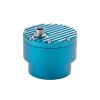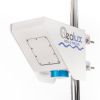VEGA VEGAPULS C 23 Radar Water Level Sensor
Features
- Measuring range up to 30m with ≤ 2mm accuracy
- Low power consumption with flexible operating voltage from 8 to 30 VDC
- Integrated Bluetooth for configuration and SDI-12 output for data logger interface
- Free ground shipping
- Expedited repair and warranty service
- Lifetime technical support
- More
Overview
The VEGAPULS C 23 is the ideal radar sensor for non-contact level measurement with high accuracy requirements in all standard applications where a high degree of protection and particularly good signal focusing are required.
Diverse Environmental Applications
It is particularly suitable for level measurement in water treatment, in pumping stations and rain overflow basins, for flow measurement in narrow channels, for level monitoring in rivers and lakes and for many other environmental applications.
Measure Solids and Liquids
The sensor is suitable both for measuring liquids and for use on bulk solids silos or bulk solids containers. The device is designed for connection to data loggers with SDI-12 interface, making it particularly suitable for battery-powered applications requiring low power consumption as well as applications with one signal and supply cable for several sensors.
In The News
Safeguarding Communities with Real-Time Flood Monitoring in the City of Hazelwood
The City of Hazelwood is a suburb in St. Louis County, Missouri, home to around 25,500 people. Recently, the community has suffered increased flash flooding following severe storms, prompting the need for the installation of a flood monitoring system. In 2022, a NexSens X2 data logger was installed to monitor water level and rainfall in real-time, with the aim of reducing the loss of life and property as a result of extreme weather events. [caption id="attachment_39411" align="alignnone" width="940"] The latest flood event at Coldwater Creek, where the water level rose by 14 feet, exceeding the height of the X2 by three feet. The sensor can be seen behind the wall that usually contains the Creek.
Read MoreSource Water Monitoring in Albany, New York: Tracing Water Quality throughout Tributaries
Thousands of US cities pull their drinking water from natural source waters like reservoirs, rivers, and streams, making overall watershed health a key consideration for water providers. In Albany, New York, the Albany Department of Water and Water Supply delivers drinking water to over 100,000 residents as well as monitors and manages the larger drinking water supply watershed. Hannah Doherty, Environmental Specialist at the Albany Department of Water and Water Supply , spends her days working with a small team to monitor the drinking supply and the connected water bodies. Doherty explains, “We’re the first to encounter the water that ends up being the drinking water.
Read MoreWildfire Prevention in the Sierra Nevada Region with the Yuba Watershed Institute
Though recent wildfires have sparked new conversations about wildfire management and response, groups like the Yuba Watershed Institute have been monitoring the forests and water resources of the Sierra Nevada region for decades, managing approximately 5,000 acres of land with the Bureau of Land Management (BLM) and about 7,000 acres in private land partnerships. The goal of the Institute is to work with local communities and land agencies to improve watershed and forestry management through informed practices and public outreach. The goals of the Yuba Watershed Institute are three-fold: Improve the ability of fire suppression agencies like the California Department of Forestry and Fire Protection ( CAL FIRE ) and the US Forest Service.
Read More











